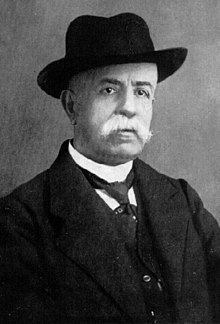
Back غريغوريو ريتشي Arabic جريجوريو ريتشى ARZ قرقریو ریتچی کورباسترو AZB Gregorio Ricci-Curbastro Catalan Gregorio Ricci-Curbastro Czech Gregorio Ricci-Curbastro German Gregorio Ricci-Curbastro Esperanto Gregorio Ricci-Curbastro Spanish Gregorio Ricci-Curbastro Basque گرگریو ریچی-کورباسترو Persian
Gregorio Ricci-Curbastro | |
|---|---|
 | |
| Born | 12 January 1853 Lugo di Romagna, Italy |
| Died | 6 August 1925 (aged 72) Bologna, Italy |
| Alma mater | Sapienza University of Rome University of Bologna Scuola Normale Superiore di Pisa |
| Known for | Tensor calculus Covariant derivative Ricci calculus Ricci curvature Ricci decomposition Ricci grid Ricci identity |
| Scientific career | |
| Fields | Mathematics |
| Doctoral advisor | Ulisse Dini Enrico Betti |
| Doctoral students | Tullio Levi-Civita |
| Signature | |
Gregorio Ricci-Curbastro (Italian: [ɡreˈɡɔːrjo ˈrittʃi kurˈbastro]; 12 January 1853 – 6 August 1925) was an Italian mathematician.[1] He is most famous as the discoverer of tensor calculus.
With his former student Tullio Levi-Civita, he wrote his most famous single publication,[2] a pioneering work on the calculus of tensors, signing it as Gregorio Ricci. This appears to be the only time that Ricci-Curbastro used the shortened form of his name in a publication, and continues to cause confusion.
Ricci-Curbastro also published important works in other fields, including a book on higher algebra and infinitesimal analysis,[3] and papers on the theory of real numbers, an area in which he extended the research begun by Richard Dedekind.[4]
- ^ Levi-Civita, Tullio (1926), "Commemorazione del socio nazionale prof. Gregorio Ricci-Curbastro" [Commemoration of national member Gregorio Ricci-Curbastro read by member T. Levi-Civita at the meeting of 3 January 1926], Mem. Accad. Lincei (in Italian), 1 (8): 555–564
- ^ Ricci, Gregorio; Levi-Civita, Tullio (March 1900). "Méthodes de calcul différentiel absolu et leurs applications" [Methods of the absolute differential calculus and their applications]. Mathematische Annalen (in French). 54 (1–2). Springer: 125–201. doi:10.1007/BF01454201. S2CID 120009332.
- ^ Ricci-Curbastro, Gregorio (1918), Lezioni di Analisi algebrica ed infinitesimale (1926 ed.), Padova: Tip. Universitaria
- ^ Ricci-Curbastro, Gregorio (1897), "Della teoria dei numeri reali secondo il concetto di Dedekind", Gior. Di Matem., 35: 22–74